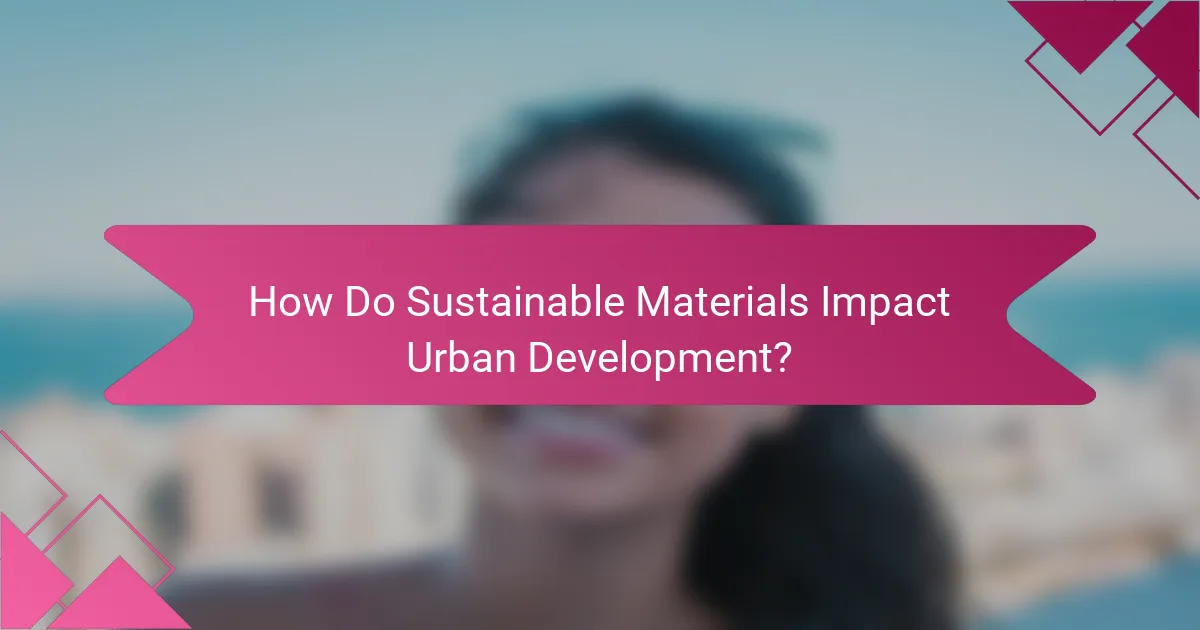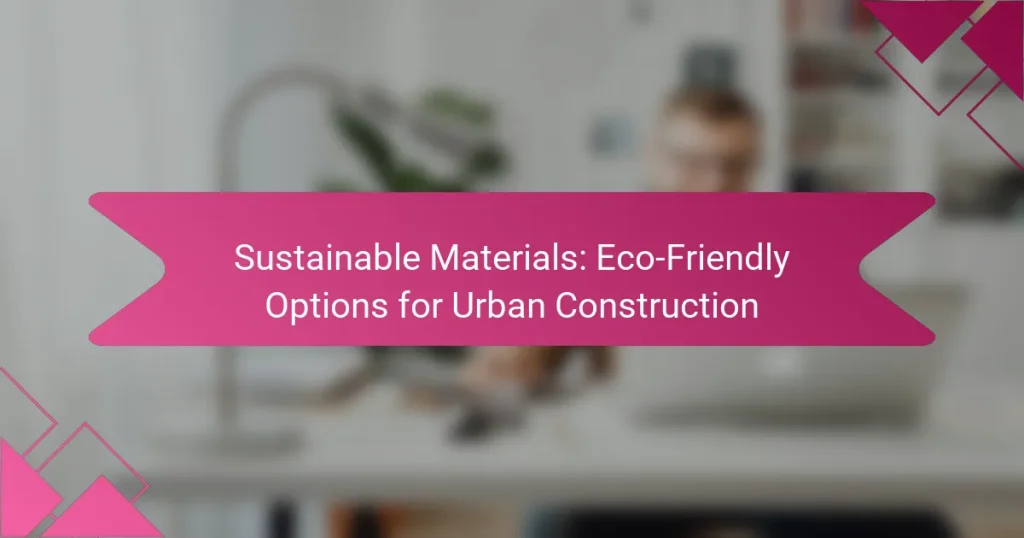Incorporating sustainable materials into urban construction is essential for minimizing environmental impact while ensuring durability and functionality. Options like bamboo, recycled steel, and reclaimed wood not only enhance building efficiency but also contribute to healthier living spaces and reduced carbon footprints.

What Are the Best Sustainable Materials for Urban Construction?
The best sustainable materials for urban construction include options that minimize environmental impact while providing durability and functionality. Key materials such as bamboo, recycled steel, rammed earth, reclaimed wood, and hempcrete offer eco-friendly alternatives that can enhance building efficiency and reduce carbon footprints.
Bamboo
Bamboo is a fast-growing grass that can be harvested sustainably, making it an excellent choice for urban construction. Its high strength-to-weight ratio allows for versatile applications, from structural beams to flooring.
When using bamboo, consider local sourcing to reduce transportation emissions. Ensure that the bamboo is treated properly to enhance durability and resistance to pests.
Recycled Steel
Recycled steel is a robust material that significantly reduces the need for new metal production, thus lowering energy consumption and greenhouse gas emissions. It can be used for structural frameworks, roofing, and reinforcements.
When selecting recycled steel, check for certifications that confirm the percentage of recycled content. This ensures you are contributing to a circular economy while maintaining structural integrity.
Rammed Earth
Rammed earth is a natural building material made from compacted soil, providing excellent thermal mass and insulation properties. It is particularly effective in climates where temperature regulation is essential.
Consider local soil types when planning rammed earth construction, as the right mixture can enhance performance. Ensure compliance with local building codes regarding earth construction techniques.
Reclaimed Wood
Reclaimed wood is salvaged from old buildings, reducing the demand for new lumber and preserving forests. It adds character and warmth to urban spaces while being a sustainable choice.
When using reclaimed wood, inspect it for structural integrity and potential contaminants. Source from reputable suppliers who can provide history and treatment details to ensure safety and quality.
Hempcrete
Hempcrete is a biocomposite material made from hemp hurds and lime, offering excellent insulation and breathability. It is lightweight and contributes to carbon sequestration, making it a sustainable choice for walls and insulation.
While hempcrete is not load-bearing, it can be combined with other materials for structural applications. Be aware of local regulations regarding the use of hemp in construction, as they can vary significantly.

How Do Sustainable Materials Impact Urban Development?
Sustainable materials significantly influence urban development by reducing environmental impact and promoting healthier living spaces. Their use leads to lower resource consumption, improved energy efficiency, and enhanced quality of life for residents.
Reduced Carbon Footprint
Utilizing sustainable materials in urban construction helps minimize the carbon footprint of buildings. Materials such as recycled steel, bamboo, and reclaimed wood require less energy to produce and transport, which directly lowers greenhouse gas emissions.
For instance, buildings made from recycled materials can reduce carbon emissions by up to 30% compared to those using traditional materials. Choosing local suppliers further decreases transportation emissions, making a significant difference in urban settings.
Enhanced Energy Efficiency
Sustainable materials contribute to enhanced energy efficiency in buildings, which can lead to lower utility costs. Insulation made from natural fibers or recycled materials can improve thermal performance, reducing the need for heating and cooling.
Incorporating energy-efficient windows and green roofs can further optimize energy use. Buildings designed with these materials often achieve energy savings of 20-50%, making them more cost-effective over time.
Improved Indoor Air Quality
The use of sustainable materials can greatly enhance indoor air quality, which is crucial for occupant health. Many eco-friendly materials are free from volatile organic compounds (VOCs) and other harmful chemicals commonly found in traditional construction materials.
For example, low-VOC paints and finishes, along with natural flooring options like cork or bamboo, help create a healthier indoor environment. This focus on air quality can lead to increased productivity and well-being for residents and workers in urban developments.

What Are the Cost Implications of Using Eco-Friendly Materials?
Using eco-friendly materials in urban construction can initially seem more expensive, but they often lead to significant long-term savings. The cost implications involve not only the upfront investment but also potential savings from energy efficiency, maintenance, and government incentives.
Initial Investment vs. Long-Term Savings
The initial investment for eco-friendly materials can be higher than traditional options, often ranging from 10-30% more. However, these materials typically offer better durability and energy efficiency, which can reduce operational costs over time.
For instance, using recycled steel or sustainably sourced wood may cost more upfront but can lead to savings on energy bills and maintenance. Over a building’s lifespan, these savings can offset the initial costs, making eco-friendly choices financially viable.
Availability of Government Incentives
Many governments offer incentives for using sustainable materials, which can significantly reduce costs. These incentives may include tax credits, grants, or rebates aimed at promoting eco-friendly construction practices.
For example, in the United States, programs like the Energy Efficient Home Credit can provide substantial financial benefits for builders who incorporate energy-efficient materials. It’s essential to research local regulations and available incentives to maximize savings.
Market Demand Effects
As demand for eco-friendly materials increases, prices may stabilize or even decrease over time due to economies of scale. Builders and developers who invest in sustainable materials may find themselves at a competitive advantage as consumers increasingly prefer green buildings.
Moreover, properties constructed with eco-friendly materials often have higher resale values, reflecting the growing market demand for sustainable living options. This trend can enhance long-term investment returns for developers and homeowners alike.

What Regulations Govern Sustainable Construction Materials in the US?
In the US, sustainable construction materials are primarily governed by a combination of federal, state, and local regulations that promote environmental responsibility. Key regulations focus on energy efficiency, material sourcing, and waste management, ensuring that construction practices minimize ecological impact.
LEED Certification Standards
LEED (Leadership in Energy and Environmental Design) certification sets a benchmark for sustainable building practices in the US. Projects can earn points based on various criteria, including the use of sustainable materials, energy efficiency, and water conservation. Achieving LEED certification can enhance a building’s marketability and reduce operating costs.
To qualify for LEED certification, builders should consider using materials that are recycled, rapidly renewable, or sourced from sustainable practices. For example, bamboo flooring and recycled steel are popular choices that contribute to LEED points. Understanding the specific requirements for different certification levels—Certified, Silver, Gold, and Platinum—can help project teams strategize effectively.
Energy Policy Act Compliance
The Energy Policy Act (EPAct) of 2005 encourages energy efficiency in buildings, impacting the choice of sustainable materials. This federal law mandates energy-saving measures and provides tax incentives for energy-efficient construction and renovations. Compliance with EPAct can significantly influence material selection and design strategies.
To align with EPAct, builders should focus on materials that enhance energy performance, such as high-insulation windows and energy-efficient HVAC systems. It’s essential to stay updated on state-specific adaptations of the EPAct, as they may impose additional requirements or incentives that further promote sustainable practices in urban construction.

How to Choose the Right Sustainable Materials for Your Project?
Choosing the right sustainable materials for your construction project involves understanding your specific needs and the environmental impact of various options. Prioritize materials that are renewable, recyclable, and have low carbon footprints to ensure your project aligns with eco-friendly principles.
Assessing Project Requirements
Begin by clearly defining the requirements of your project, including budget, structural needs, and aesthetic goals. Consider local climate conditions, as materials may perform differently based on environmental factors. For example, wood may be ideal in temperate zones, while concrete might be better suited for areas prone to extreme weather.
Engage with stakeholders to gather input on preferences and sustainability goals. This collaboration can help identify materials that not only meet functional needs but also resonate with the community’s values regarding sustainability.
Evaluating Material Performance
Assess the performance characteristics of potential materials, such as durability, maintenance needs, and energy efficiency. Look for certifications like LEED or BREEAM, which indicate adherence to sustainability standards. For instance, materials with high thermal mass can reduce energy consumption for heating and cooling.
Conduct a life cycle assessment (LCA) to evaluate the environmental impact from production to disposal. This analysis can reveal trade-offs; for example, while recycled steel may have a higher upfront cost, it often offers superior longevity and lower maintenance expenses over time.


